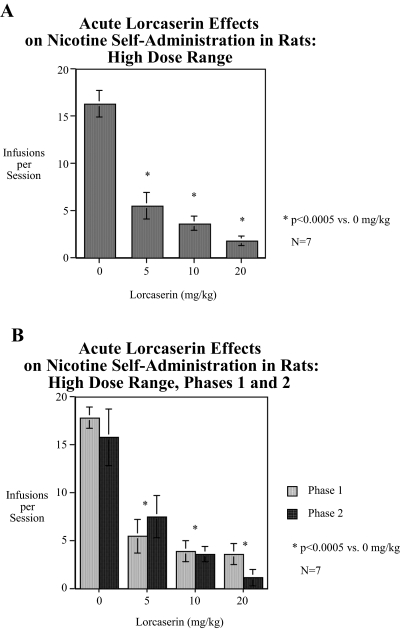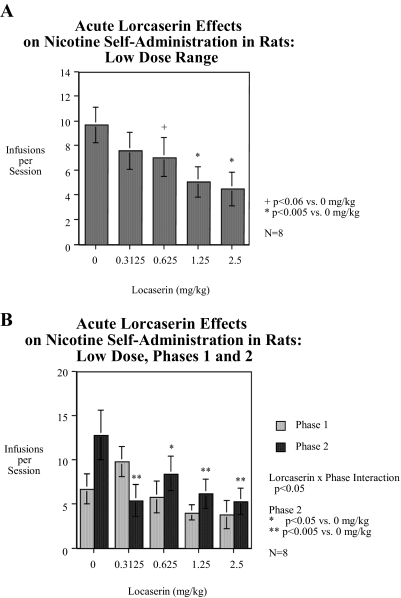
| Size | Price | Stock | Qty |
|---|---|---|---|
| 10mg |
|
||
| 25mg |
|
||
| 50mg |
|
||
| 100mg |
|
||
| 250mg |
|
||
| 500mg |
|
||
| Other Sizes |
|
Purity: ≥98%
Lorcaserin HCl (Belviq Xr; APD-356; APD356; Lorqess), the hydrochloride salt of Lorcaserin which is a marketed weight-loss drug, is a potent and selective full agonist of human 5-HT2C (serotonin) receptor with Ki of 15 nM. It suppresses appetite by triggering the hypothalamic 5-HT2C receptor, which is known to regulate appetite.
| Targets |
RAAS
|
||
|---|---|---|---|
| ln Vitro |
|
||
| ln Vivo |
|
||
| Animal Protocol |
|
||
| References | |||
| Additional Infomation |
Lorcaserin hydrochloride is a hydrochloride obtained by reaction of lorcaserin with one equivalent of hydrochloric acid. Used as an anti-obesity drug. It has a role as a serotonergic agonist and an appetite depressant. It contains a lorcaserin(1+).
See also: Lorcaserin (has active moiety); Lorcaserin hydrochloride hemihydrate (annotation moved to). |
| Molecular Formula |
C11H15CL2N
|
|
|---|---|---|
| Molecular Weight |
232.15
|
|
| Exact Mass |
231.058
|
|
| CAS # |
846589-98-8
|
|
| Related CAS # |
|
|
| PubChem CID |
11673085
|
|
| Appearance |
Typically exists as solid at room temperature
|
|
| LogP |
3.72
|
|
| Hydrogen Bond Donor Count |
2
|
|
| Hydrogen Bond Acceptor Count |
1
|
|
| Rotatable Bond Count |
0
|
|
| Heavy Atom Count |
14
|
|
| Complexity |
172
|
|
| Defined Atom Stereocenter Count |
1
|
|
| SMILES |
C[C@H]1CNCCC2C=CC(=CC1=2)Cl.Cl
|
|
| InChi Key |
ITIHHRMYZPNGRC-QRPNPIFTSA-N
|
|
| InChi Code |
InChI=1S/C11H14ClN.ClH/c1-8-7-13-5-4-9-2-3-10(12)6-11(8)9;/h2-3,6,8,13H,4-5,7H2,1H3;1H/t8-;/m0./s1
|
|
| Chemical Name |
(5R)-7-chloro-5-methyl-2,3,4,5-tetrahydro-1H-3-benzazepine;hydrochloride
|
|
| Synonyms |
|
|
| HS Tariff Code |
2934.99.9001
|
|
| Storage |
Powder -20°C 3 years 4°C 2 years In solvent -80°C 6 months -20°C 1 month |
|
| Shipping Condition |
Room temperature (This product is stable at ambient temperature for a few days during ordinary shipping and time spent in Customs)
|
| Solubility (In Vitro) |
|
|||
|---|---|---|---|---|
| Solubility (In Vivo) |
5%DMSO + 40%PEG300 + 5%Tween 80: 5.0mg/ml (5.46mM) (Please use freshly prepared in vivo formulations for optimal results.)
|
| Preparing Stock Solutions | 1 mg | 5 mg | 10 mg | |
| 1 mM | 4.3076 mL | 21.5378 mL | 43.0756 mL | |
| 5 mM | 0.8615 mL | 4.3076 mL | 8.6151 mL | |
| 10 mM | 0.4308 mL | 2.1538 mL | 4.3076 mL |
*Note: Please select an appropriate solvent for the preparation of stock solution based on your experiment needs. For most products, DMSO can be used for preparing stock solutions (e.g. 5 mM, 10 mM, or 20 mM concentration); some products with high aqueous solubility may be dissolved in water directly. Solubility information is available at the above Solubility Data section. Once the stock solution is prepared, aliquot it to routine usage volumes and store at -20°C or -80°C. Avoid repeated freeze and thaw cycles.
Calculation results
Working concentration: mg/mL;
Method for preparing DMSO stock solution: mg drug pre-dissolved in μL DMSO (stock solution concentration mg/mL). Please contact us first if the concentration exceeds the DMSO solubility of the batch of drug.
Method for preparing in vivo formulation::Take μL DMSO stock solution, next add μL PEG300, mix and clarify, next addμL Tween 80, mix and clarify, next add μL ddH2O,mix and clarify.
(1) Please be sure that the solution is clear before the addition of next solvent. Dissolution methods like vortex, ultrasound or warming and heat may be used to aid dissolving.
(2) Be sure to add the solvent(s) in order.
| NCT Number | Recruitment | interventions | Conditions | Sponsor/Collaborators | Start Date | Phases |
| NCT02400359 | Active Recruiting |
Drug: Lorcaserin HCl Drug: Placebo |
Obesity Weight Loss |
Beth Israel Deaconess Medical Center |
October 2014 | Phase 4 |
| NCT02019264 | Completed | Drug: Lorcaserin hydrochloride Drug: Placebo |
Obesity Overweight Type 2 Diabetes |
Eisai Inc. | January 24, 2014 | Phase 4 |
| NCT02398669 | Completed | Drug: Lorcaserin hydrochloride | Obesity | Eisai Inc. | March 2015 | Phase 1 |
| NCT00829140 | Completed | Drug: Placebo Drug: Lorcaserin 10mg BID |
Obesity | Eisai Inc. | November 2008 | Phase 1 |
| NCT00395135 | Completed | Drug: Lorcaserin 10 mg BID Drug: Matching Placebo BID |
Obesity | Eisai Inc. | November 2006 | Phase 3 |
 |
|---|
 |